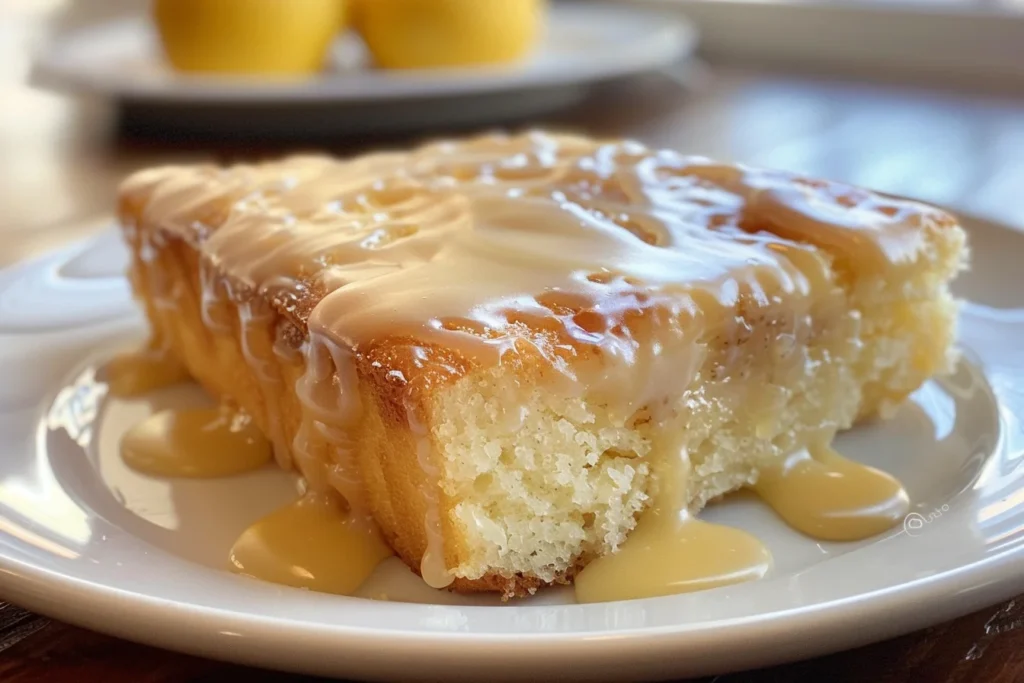
Ever tried baking a sheet cake that stays moist for days, has a tangy kick, and tastes like it came from a fancy bakery? If not, it’s time to introduce kefir into your baking game! 🧁 In this guide, we’ll explore how kefir—a fermented milk product—can elevate a humble sheet cake into a masterpiece. You’ll also get the lowdown on the essential ingredients, common problems, and tips to ensure your cake turns out perfect every time. So, let’s get our aprons on and dive in!
What Is Kefir and Why Is It Perfect for Baking?
Let’s start with the basics. You might be wondering: What exactly is kefir, and why should I use it in my cake?
Kefir is a tangy, fermented dairy product that works wonders in baking. Its acidic nature reacts with baking soda to create a fluffy texture. If you’re new to baking with kefir, check out this guide to a kefir sheet cake recipe for step-by-step instructions.
Think of kefir as yogurt’s cooler cousin. It’s a fermented dairy product that’s packed with probiotics (the good bacteria), giving it a tangy flavor. But there’s more to it than just taste. Kefir is a magical ingredient in baking because it makes cakes:
- Super moist (say goodbye to dry cakes!)
- Light and fluffy (thanks to its acidic properties)
- Full of flavor (it’s a game-changer for plain cakes)
“Baking with kefir is like giving your cake a spa day—it relaxes the gluten, tenderizes the crumb, and adds a little zing.” 🧑🍳
Understanding Kefir: Fermented Milk Basics
Let’s break it down a bit more. Kefir is made by fermenting milk with kefir grains (not actual grains but a mix of bacteria and yeast). This fermentation process creates a drink that’s tangy, creamy, and full of probiotics.
There are two main types of kefir:
- Milk Kefir – The one we use in baking, made from cow, goat, or sheep milk.
- Water Kefir – A dairy-free version made with sugary water (but this one’s not ideal for cakes).
Now, if you’ve never tasted kefir before, imagine a drink that’s like a thinner, tangier yogurt. It’s slightly fizzy and has a unique zing to it. That zing is what transforms your cake from bland to wow!
“Using kefir in your sheet cake batter is like adding a splash of magic potion—it boosts moisture and gives your cake that bakery-style taste!”
The Essential Ingredients for a Perfect Kefir Sheet Cake
Alright, now that we’re sold on kefir’s magic, let’s talk ingredients. You can’t just throw random stuff into a bowl and hope for the best, right? Here’s a breakdown of what you’ll need for the perfect kefir sheet cake.
For a unique twist, you can try pairing your kefir cake with a strawberry waffles recipe for a complete brunch spread!
Choosing the Right Type of Kefir (Plain, Flavored, or Homemade)
When it comes to kefir, plain unsweetened kefir is your best bet for baking. Why? Because flavored kefirs (like strawberry or vanilla) often have added sugars and flavors that can throw off your recipe.
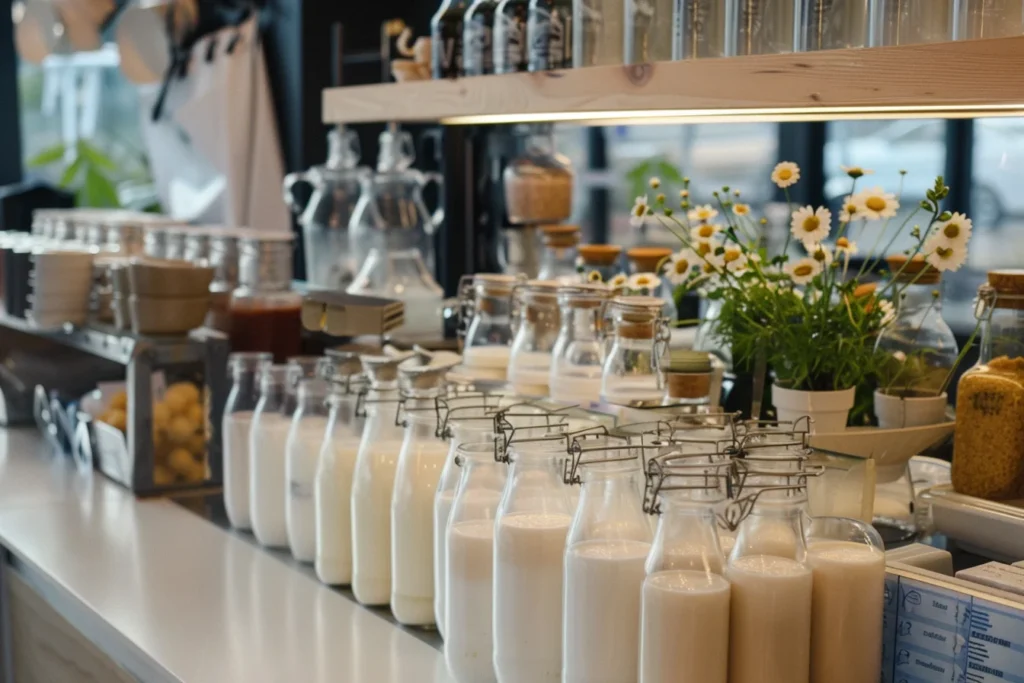
Thinking of making your own kefir? You can! Homemade kefir tends to be thicker and tangier, which works great in cakes. Just be sure to strain it well.
✅ Pro Tip:
If you can’t find kefir at your local grocery store, buttermilk or Greek yogurt can be good substitutes, but trust me, the flavor won’t be as complex.
Flour Options: All-Purpose vs. Whole Wheat for Kefir Sheet Cake
Flour is the backbone of any cake. For a kefir sheet cake, all-purpose flour is the most common choice because it gives the cake a soft and tender crumb.
But if you want to add a bit of healthy flair, try using whole wheat flour or even almond flour. Just remember that whole wheat flour can make your cake denser, so you may want to mix it with all-purpose flour for the best texture.
✅ Pro Tip:
Sift your flour before adding it to the batter to avoid clumps and ensure a light, airy cake.
Sweeteners: Sugar, Honey, or Alternatives?
Traditionally, sheet cakes use granulated sugar for sweetness. However, if you’re feeling adventurous, you can try:
- Honey – Adds moisture and a floral note.
- Brown sugar – Makes the cake richer and adds a hint of caramel flavor.
- Coconut sugar – A healthier alternative with a nutty taste.
But remember, different sweeteners affect the cake’s texture and moisture levels, so stick with granulated sugar if you want to play it safe.
Fat Choices: Butter, Oil, or Kefir Itself?
Here’s where things get interesting. In most cakes, fat (like butter or oil) is what makes the cake moist and tender. But in a kefir cake, kefir itself acts as a fat substitute!
Still, you’ll need some added fat for that rich taste. You can use:
- Butter – For a classic flavor.
- Vegetable oil – For a lighter, moister cake.
- Coconut oil – For a subtle coconut twist.
✅ Pro Tip:
Use room-temperature butter to ensure it blends smoothly into the batter.
Leavening Agents: Baking Soda vs. Baking Powder
Leavening agents are crucial in any cake recipe. For kefir sheet cake, you’ll need:
- Baking soda – Works best because it reacts with kefir’s acidity to create bubbles, making the cake rise.
- Baking powder – Can be used, but it’s not as effective with kefir.
Make sure your baking soda is fresh, or you’ll end up with a flat cake.
Flavor Enhancements: Vanilla, Citrus Zest, and More
Want to take your kefir sheet cake to the next level? Add some flavor enhancers:
- Vanilla extract – A must-have for that classic cake flavor.
- Citrus zest (like lemon or orange) – Adds a refreshing twist.
- Spices (like cinnamon or nutmeg) – For a warm, cozy flavor.
“Think of these enhancers as the accessories to your cake—they don’t steal the show but make everything look (and taste) better!” 🎩
Why Kefir Enhances the Texture and Flavor of Cakes
Here’s the science-y bit (but I’ll keep it simple). The acidity in kefir breaks down gluten in the flour, making the cake softer. It also reacts with baking soda, creating carbon dioxide bubbles that make the cake light and fluffy.
In short: Kefir = Moist, Fluffy Cake Magic ✨
Optional Ingredients for Customizing Your Kefir Sheet Cake
Sure, a classic kefir sheet cake is delicious on its own, but why stop there? Think of your kefir cake as a blank canvas waiting for your creativity. Whether you’re into fruity twists, nutty surprises, or spicy kicks, there are endless ways to make your cake truly yours. Let’s dive into some optional ingredients that can take your cake from “yum” to “WOW!”
Adding Fruits: Berries, Apples, or Bananas 🍓🍌🍎
Adding fresh or dried fruits to your kefir sheet cake can transform it into something spectacular. Here are some ideas:
- Berries (blueberries, raspberries, or strawberries): Toss a handful into your batter for a burst of fruity goodness in every bite.
- Apples: Grated or diced apples add moisture and a natural sweetness to your cake.
- Bananas: Got overripe bananas lying around? Mash them up and mix them in for a banana-kefir hybrid cake.
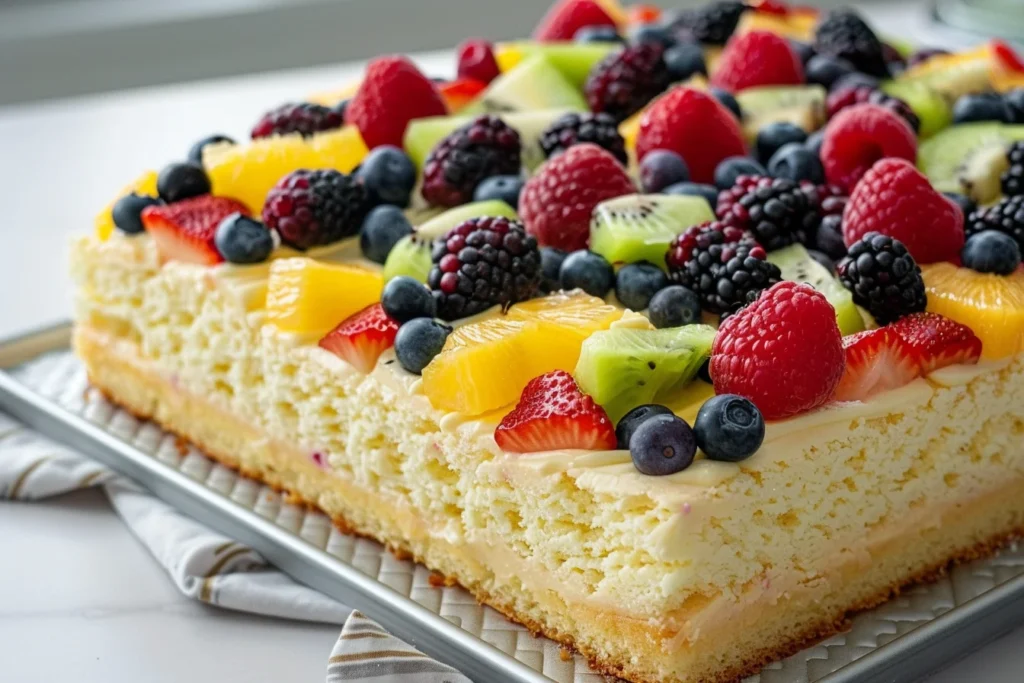
✅ Pro Tip:
If you’re using fresh fruits, coat them in a little flour before adding to the batter. This prevents them from sinking to the bottom during baking.
Nuts and Seeds: Crunchy Additions for Texture 🥜🌰
Want a bit of crunch? Adding nuts and seeds is a great way to add texture to your kefir cake. Some popular choices include:
- Walnuts or Pecans: Add a nutty flavor that pairs well with the tangy kefir.
- Almonds: For a more subtle crunch and a hint of sweetness.
- Chia Seeds or Poppy Seeds: Perfect for a unique texture and a slight crunch with every bite.
“Adding nuts or seeds is like giving your cake a surprise inside—each bite has a little something extra to keep things interesting!”
Spices to Elevate the Flavor (Cinnamon, Nutmeg, Cardamom) 🌶️
If you love the warm, cozy flavors of fall, spices are your best friend. Here are some spices that work beautifully in a kefir sheet cake:
- Cinnamon: A classic addition that adds warmth and depth.
- Nutmeg: Adds a slightly sweet, nutty flavor.
- Cardamom: For a more exotic twist with a hint of citrus.
Feel free to mix and match! A cinnamon-cardamom combo can give your cake a sophisticated flavor profile that will have people asking for seconds.
Step-by-Step Guide to Preparing Kefir Sheet Cake Batter
Now that we’ve covered the ingredients, let’s get to the fun part—making the batter! 🎉 Follow these step-by-step instructions to ensure your cake comes out perfectly every time.
Step 1: Prepping the Ingredients for Optimal Results
Before you start, make sure all your ingredients are at room temperature. Why? Because room-temperature ingredients mix better, giving you a smoother, more even batter.
Here’s your basic checklist:
- Kefir – 1 cup
- All-purpose flour – 2 cups
- Sugar – 1 cup
- Eggs – 2 large
- Butter or oil – ½ cup
- Baking soda – 1 teaspoon
- Vanilla extract – 1 teaspoon
- Salt – A pinch
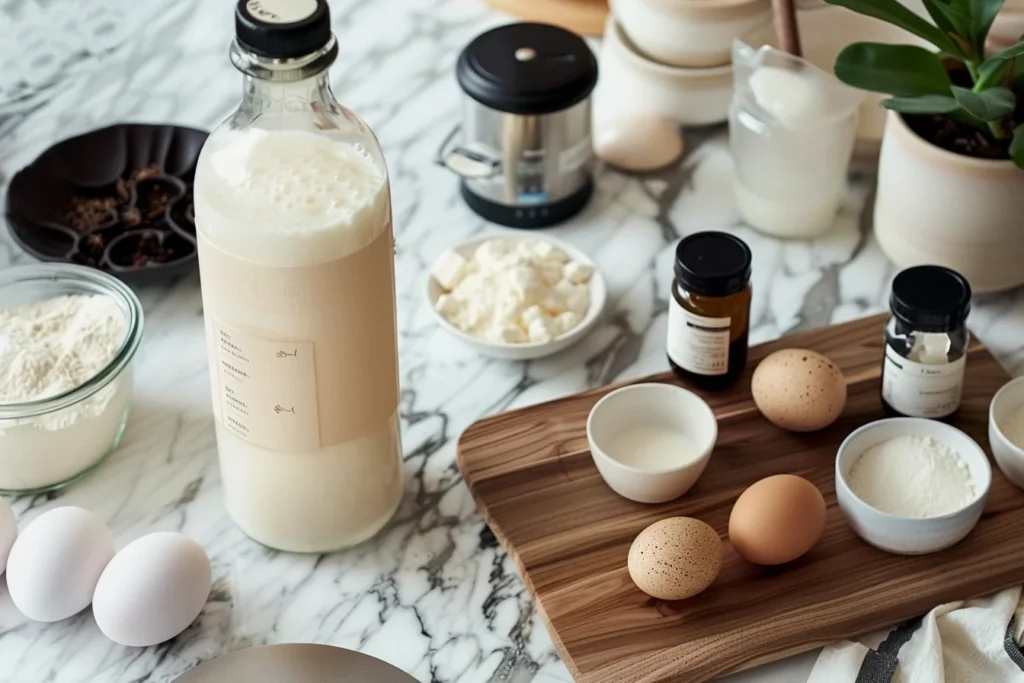
Step 2: Mixing Techniques: How to Avoid Overmixing
When mixing your batter, it’s important to remember one golden rule: Don’t overmix! 🙅♀️
Why? Because overmixing activates the gluten in the flour, which can make your cake dense and chewy. Instead, follow this method:
- Cream the butter and sugar until light and fluffy.
- Add the eggs one at a time, mixing well after each addition.
- Mix in the kefir and vanilla extract until combined.
- In a separate bowl, whisk together the dry ingredients (flour, baking soda, and salt).
- Gradually fold the dry ingredients into the wet mixture until just combined.
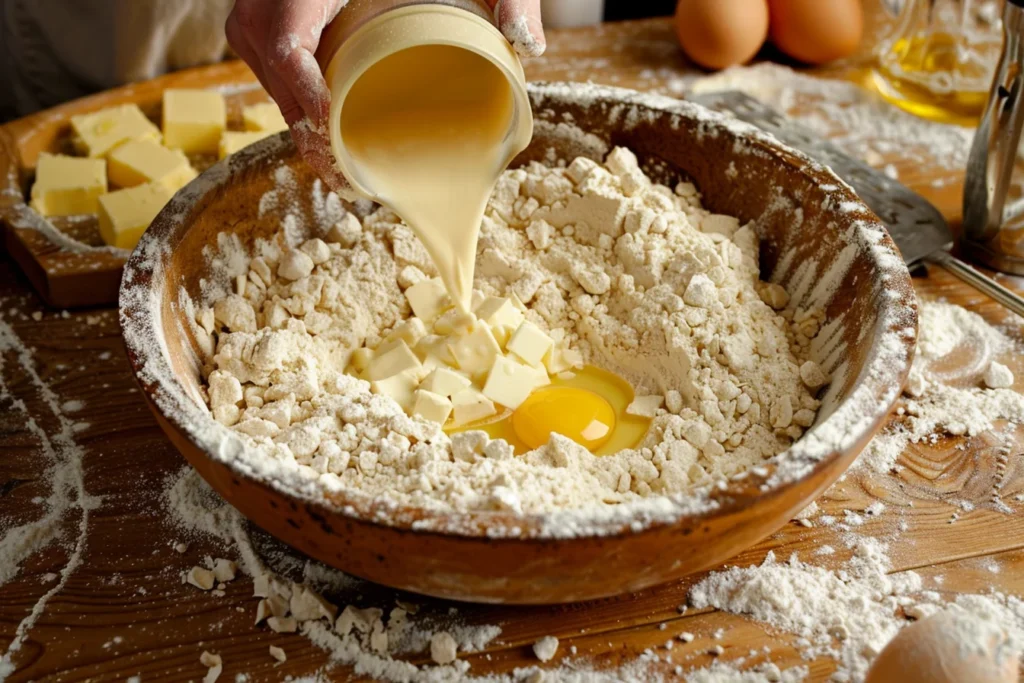
“Think of your batter as a delicate dance partner—you want to be gentle and smooth, not aggressive!” 💃🕺
Step 3: Common Mistakes to Avoid When Making the Batter
Even experienced bakers can make mistakes. Here are some common ones to watch out for:
- Using cold ingredients – This can cause your batter to curdle.
- Skipping the sifting step – Sifting the flour helps prevent lumps.
- Overmixing the batter – As we mentioned earlier, this can lead to a dense cake.
✅ Pro Tip:
If your batter looks too thick, you can add a splash of kefir to loosen it up.
Baking the Kefir Sheet Cake to Perfection
Okay, your batter is ready. Now, let’s talk about baking. This step can make or break your cake, so pay close attention!
A dense cake can be caused by overmixing or not using enough leavening agents. For a lighter texture, make sure your baking soda is fresh and measure accurately. If you’re interested in learning more about using unique ingredients in desserts, check out the Xango dessert guide.
Ideal Temperature and Baking Time ⏰
For a perfect kefir sheet cake, preheat your oven to 350°F (175°C) and bake for 30 to 35 minutes.
Here’s how to ensure your cake bakes evenly:
- Preheat your oven properly.
- Use a greased or parchment-lined baking sheet.
- Place the cake on the middle rack to ensure even heat distribution.
“Baking a cake is like telling a story—timing is everything, and patience is key.” 📚
How to Know When Your Cake Is Done ✅
There’s nothing worse than slicing into a cake only to find it’s raw in the middle. 😩 To avoid this disaster, use the toothpick test:
- Insert a toothpick into the center of the cake.
- If it comes out clean, your cake is done.
- If it has batter on it, bake for a few more minutes.
Troubleshooting Undercooked or Overbaked Cake Issues
Sometimes things go wrong. Here’s how to fix common baking problems:
❓ Problem: The cake is raw in the middle.
💡 Solution: Cover it with foil and bake for another 5-10 minutes.
❓ Problem: The cake is too dry.
💡 Solution: Brush it with a simple syrup (sugar + water) to add moisture.
Decorating and Serving Ideas for Kefir Sheet Cake 🎂
You’ve baked your kefir sheet cake to perfection—now it’s time to make it look (and taste) even better! Decorating a sheet cake can be simple or extravagant, depending on your mood. Here are some ideas to elevate your cake presentation.
Simple Toppings: Icing, Glaze, or Powdered Sugar
If you’re in a hurry or prefer a minimalist approach, you can keep things simple with:
- Powdered Sugar: A quick dusting can add elegance.
- Glaze: A thin, sweet glaze (made with powdered sugar and milk) adds moisture and shine.
- Buttercream Icing: For a more traditional cake look, whip up some buttercream and spread it evenly over the top.
Creative Ideas: Layering, Frosting, and Garnishes 🍫🍒
Feeling fancy? Here are some creative ideas to make your kefir sheet cake stand out:
- Layer It: Cut your sheet cake in half and layer it with cream or jam.
- Decorate with Fresh Fruits: Top your cake with berries or citrus slices for a fresh look.
- Add a Chocolate Drizzle: Melt some chocolate and drizzle it over the cake for a rich touch.
“Think of decorating your cake like dressing up for a party—it should match the vibe you’re going for!” 🎉
Common Problems and Solutions When Making Kefir Sheet Cake
Even the best bakers run into issues from time to time. Don’t worry! I’ve got you covered with solutions to the most common problems.
Why Is My Kefir Sheet Cake Too Dense? 🤔
A dense cake usually means one thing: overmixing the batter.
💡 Solution: Be gentle with your mixing. Once you add the dry ingredients, fold them in until just combined.
Why Did My Cake Crack on Top? 😟
Cracks can happen if the oven temperature is too high or if your batter is too dry.
💡 Solution: Double-check your oven temperature and make sure you’re using enough kefir to keep the batter moist.
How to Fix a Dry Kefir Sheet Cake
A dry cake can be disappointing, but it’s not the end of the world.
💡 Solution: Brush your cake with a simple syrup (equal parts sugar and water) to add moisture. You can also add a layer of frosting or glaze to help lock in moisture.
How to Achieve a Fluffy and Moist Texture Every Time
Consistency is key when baking. Here’s how to ensure your kefir sheet cake is always fluffy and moist:
- Use fresh kefir for the best results.
- Don’t overmix the batter.
- Bake at the right temperature.
- Don’t overbake—keep an eye on your cake in the last few minutes of baking.
Health Benefits of Kefir in Baking 🥛
Why is kefir such a great ingredient? Aside from its baking benefits, it’s also a nutritional powerhouse.
- Probiotics: Good for gut health.
- Lower Fat Content: Compared to traditional dairy products.
- Rich in Nutrients: Calcium, protein, and vitamins.
So, next time someone asks why your cake is so good, you can say it’s not just delicious—it’s healthy too! 😉
Tips for Storing and Reheating Kefir Sheet Cake 🍰
You’ve got leftovers? Lucky you! Here’s how to store and reheat your cake to keep it as delicious as the day you made it.
Proper Storage Methods to Retain Freshness
To keep your cake fresh:
- Room Temperature: Store it in an airtight container for up to 2 days.
- Refrigerator: Keeps for up to a week.
- Freezer: Freeze individual slices for up to 3 months. Wrap them in plastic wrap, then foil.
How to Reheat Without Drying Out the Cake
Reheating cake can be tricky—you don’t want it to dry out. Here’s how:
- Microwave: Wrap a slice in a damp paper towel and microwave for 10-15 seconds.
- Oven: Warm in a preheated oven at 300°F (150°C) for about 10 minutes.
Variations of Kefir Sheet Cake Recipes 🍽️
Want to switch things up? Here are some fun variations to try.
Vegan Kefir Sheet Cake: Dairy-Free Options
Swap out traditional kefir with plant-based kefir (like coconut or almond kefir) to make a vegan version of this cake. Use flax eggs instead of regular eggs.
Gluten-Free Kefir Sheet Cake Recipe
Use a gluten-free flour blend in place of all-purpose flour. Make sure your kefir is certified gluten-free as well.
Sugar-Free and Keto-Friendly Kefir Sheet Cake
For a low-carb version, use almond flour and a sugar substitute like stevia or erythritol.
Frequently Asked Questions (FAQs) About Kefir Sheet Cake Ingredients 📋
Got questions? You’re not alone! Here are some of the most common questions people ask about kefir sheet cake ingredients and how to make the perfect cake.
Can I Use Greek Yogurt Instead of Kefir in a Sheet Cake?
Yes, you can! Greek yogurt works as a substitute, but it won’t have the same tangy flavor that kefir sheet cake ingredients provide.
What Type of Flour Works Best for Kefir Cakes?
All-purpose flour is the best choice for a classic, fluffy cake made with kefir sheet cake ingredients. You can also experiment with whole wheat or gluten-free flours.
Can I Make a Kefir Sheet Cake Without Eggs?
Absolutely! You can use flax eggs or applesauce as an egg substitute when making your kefir sheet cake ingredients come together for a vegan-friendly version.
How Do I Make My Cake Extra Moist with Kefir?
The secret to a super moist cake is to use fresh kefir sheet cake ingredients and avoid overbaking. Adding a splash of oil or butter also helps.
How Long Does a Kefir Sheet Cake Last?
A cake made with kefir sheet cake ingredients lasts for 2 days at room temperature, up to a week in the fridge, and 3 months in the freezer.
Conclusion: Mastering the Art of Kefir Sheet Cake 🧑🍳
And there you have it—a complete guide to kefir sheet cake ingredients! Whether you’re a baking newbie or a seasoned pro, adding kefir to your cakes will transform your baking. With this guide, you’ve got everything you need to make a fluffy, moist, and delicious sheet cake that’ll impress everyone.
So, what are you waiting for? Grab some kefir and start baking!
🎉 Happy Baking! 🎉
